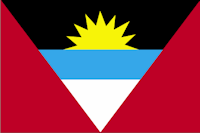Antigua & Barbuda - Geography
 The State comprises Antigua, the largest of the Leeward Islands, its sister island of Barbuda (30 miles away) and uninhabited Redonda. These islands are situated between the Caribbean Sea and the Atlantic Ocean, east-southeast of Puerto Rico. There are a total of 153km of coastline. Antigua is mainly coral-based, but is of volcanic origin in the south. Barbuda is a flat coral island.
The State comprises Antigua, the largest of the Leeward Islands, its sister island of Barbuda (30 miles away) and uninhabited Redonda. These islands are situated between the Caribbean Sea and the Atlantic Ocean, east-southeast of Puerto Rico. There are a total of 153km of coastline. Antigua is mainly coral-based, but is of volcanic origin in the south. Barbuda is a flat coral island.
With the exception of Long Island and Sandy Island, Antigua's offshore islands are all near pristine -- they show some (nlinimal) evidence of human impacts, in the form of litter left behind by fishermen and daytrippers, and the occasional poacher (birds eggs, turtle eggs, etc.).
With "365 beaches" on Antigua, further beaches of pink and white sand on Barbuda, coves that were once volcanic craters, and luxuriant palms, the country was an early proponent of sea-and-sun tourism. Antigua is generally composed of low-lying coral and limestone, although Boggy Peak among the volcanic rocks to the west rises to 402m. It has an indented coastline and a good harbour at English Harbour Town. There are a few springs; drought can be a problem. Barbuda is flat with a large lagoon on its west side. Redonda is a tiny rocky island, and is uninhabited.
As regards configuration and soil, Antigua possesses three well-marked divisions. These do not pass imperceptibly into one another, but are divided by clearly defined natural boundaries. The district to the north and east is either undulating or flat, and is composed of calcareous marls and coarse sandstones, interspersed with masses of tolerably compact limestone. The hilly district to the west and south is composed of trap rocks, with trap breccias and some basaltic greenstones.
The intermediate or central district, occupying a depressed area running diagonally across the island from St. John's Harbour to Willoughby Bay, is composed of various clayey formations ranging from loose friable marls of a yellow colour to a whitish indurated clay. In this district there are marine and fresh-water flint beds, with numerous fossils of corals and shells and interesting specimens of silicified woods.
The soils of Antigua are nowhere very deep, except in certain broad valleys. In composition they are very varied, but may be described generally as consisting of clays and calcareous marls. The stiffest clays are found in the west, the marls and light clays being found towards the centre and eastern portions. With few exceptions the Antigua soils may be described as fertile and productive. They are fortunately very retentive of moisture, and respond readily to tillage and manures.
Barbuda is one of those very few islands in the Caribbean that remains--and probably will remain for some time--so undeveloped as to seem positively deserted at times. With the exception of the guests of the island's small number of accommodations, the population seems largely to consist of the graceful Fregata magnificens, or frigate bird.
When Antigua was settled by Europeans in the 17th century it was described as a heavily wooded island where fresh water and timber could be readily obtained. Today the island is almost entirely deforested from centuries of burning and cutting down trees to plant tobacco, cotton, indigo and later sugar. This devegetation continued downstream after the decline and phase-out of export monoculture. With livestock overgrazing on the hillsides and intrusive tourism development, infrastructure construction, and sand mining in the coastal regions.
Barbuda, also settled by Europeans in the 17th century, being drier and having poorer soils, was unable to support intense agriculture, and was used primarily for raising livestock for the Codrington estates in Antigua. The livestock were allowed to run wild and today Barbuda is plagued by the problem of feral livestock (donkeys, goats, sheep, horses etc.) who are responsible for some of the destruction of Barbuda's vegetation, including such hardy species as acacias. The Barbuda environment must have been wetter wi th less scrub vegetation at the time of settlement, since the early settlers called the island "Dulcina" for its "excellence and pleasantness thereof".
|
NEWSLETTER
|
| Join the GlobalSecurity.org mailing list |
|
|
|






